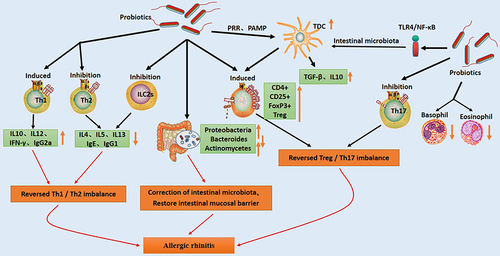Figures & data
Figure 1 Pattern of pathogenesis of allergic rhinitis.

Table 1 Treatment Options for Allergic RhinitisCitation5,Citation19
Table 2 CIassification of Probiotics and Common Representative Strains
Table 3 Recent Investigations into the Use of Probiotics for Allergic Rhinitis
Figure 2 Brief mechanism of probiotic treatment of allergic rhinitis. Probiotics protect against allergic rhinitis by reducing serum pro-inflammatory factors, increasing the number of immune cells, regulating Th1 and Th2 balance, increasing Treg numbers, and inhibiting Th17. In addition, probiotics can directly stimulate the formation of TDCs or activate the TLR pathway to indirectly stimulate DC, thereby inducing the formation of Tregs. Probiotics can improve AR by increasing the level of beneficial bacteria to regulate the stability of the gut microbiota, restoring the intestinal mucosal barrier.

